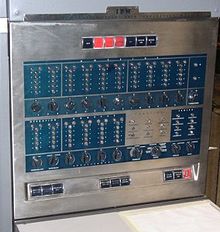
In computing and electronic systems, binary-coded decimal (BCD) is a class of binary encodings of decimal numbers where each digit is represented by a fixed number of bits, usually four or eight. Sometimes, special bit patterns are used for a sign or other indications.

In computing, floating-point arithmetic (FP) is arithmetic that represents subsets of real numbers using an integer with a fixed precision, called the significand, scaled by an integer exponent of a fixed base. Numbers of this form are called floating-point numbers. For example, 12.345 is a floating-point number in base ten with five digits of precision:
The IEEE Standard for Floating-Point Arithmetic is a technical standard for floating-point arithmetic originally established in 1985 by the Institute of Electrical and Electronics Engineers (IEEE). The standard addressed many problems found in the diverse floating-point implementations that made them difficult to use reliably and portably. Many hardware floating-point units use the IEEE 754 standard.
Hexadecimal floating point is a format for encoding floating-point numbers first introduced on the IBM System/360 computers, and supported on subsequent machines based on that architecture, as well as machines which were intended to be application-compatible with System/360.

In computer architecture, 36-bit integers, memory addresses, or other data units are those that are 36 bits wide. Also, 36-bit central processing unit (CPU) and arithmetic logic unit (ALU) architectures are those that are based on registers, address buses, or data buses of that size. 36-bit computers were popular in the early mainframe computer era from the 1950s through the early 1970s.
The Burroughs B2500 through Burroughs B4900 was a series of mainframe computers developed and manufactured by Burroughs Corporation in Pasadena, California, United States, from 1966 to 1991. They were aimed at the business world with an instruction set optimized for the COBOL programming language. They were also known as Burroughs Medium Systems, by contrast with the Burroughs Large Systems and Burroughs Small Systems.
In computing, a word is the natural unit of data used by a particular processor design. A word is a fixed-sized datum handled as a unit by the instruction set or the hardware of the processor. The number of bits or digits in a word is an important characteristic of any specific processor design or computer architecture.
The Intel BCD opcodes are a set of six x86 instructions that operate with binary-coded decimal numbers. The radix used for the representation of numbers in the x86 processors is 2. This is called a binary numeral system. However, the x86 processors do have limited support for the decimal numeral system.
Chen–Ho encoding is a memory-efficient alternate system of binary encoding for decimal digits.
Densely packed decimal (DPD) is an efficient method for binary encoding decimal digits.
Extended precision refers to floating-point number formats that provide greater precision than the basic floating-point formats. Extended precision formats support a basic format by minimizing roundoff and overflow errors in intermediate values of expressions on the base format. In contrast to extended precision, arbitrary-precision arithmetic refers to implementations of much larger numeric types using special software.
Decimal floating-point (DFP) arithmetic refers to both a representation and operations on decimal floating-point numbers. Working directly with decimal (base-10) fractions can avoid the rounding errors that otherwise typically occur when converting between decimal fractions and binary (base-2) fractions.
The IEEE 754-2008 standard includes decimal floating-point number formats in which the significand and the exponent can be encoded in two ways, referred to as binary encoding and decimal encoding.
An instruction set architecture (ISA) is an abstract model of a computer, also referred to as computer architecture. A realization of an ISA is called an implementation. An ISA permits multiple implementations that may vary in performance, physical size, and monetary cost ; because the ISA serves as the interface between software and hardware. Software that has been written for an ISA can run on different implementations of the same ISA. This has enabled binary compatibility between different generations of computers to be easily achieved, and the development of computer families. Both of these developments have helped to lower the cost of computers and to increase their applicability. For these reasons, the ISA is one of the most important abstractions in computing today.
In computing, quadruple precision is a binary floating-point–based computer number format that occupies 16 bytes with precision at least twice the 53-bit double precision.
In computing, decimal32 is a decimal floating-point computer numbering format that occupies 4 bytes (32 bits) in computer memory. It is intended for applications where it is necessary to emulate decimal rounding exactly, such as financial and tax computations. Like the binary16 format, it is intended for memory saving storage.
In computing, decimal64 is a decimal floating-point computer numbering format that occupies 8 bytes in computer memory. It is intended for applications where it is necessary to emulate decimal rounding exactly, such as financial and tax computations.
decimal128 is a decimal floating-point computer number format that occupies 128 bits in computer memory. Formally introduced in IEEE 754-2008, it is intended for applications where it is necessary to emulate decimal rounding exactly, such as financial and tax computations.
BCD, also called alphanumeric BCD, alphameric BCD, BCD Interchange Code, or BCDIC, is a family of representations of numerals, uppercase Latin letters, and some special and control characters as six-bit character codes.
In computer engineering, a register–memory architecture is an instruction set architecture that allows operations to be performed on memory, as well as registers. If the architecture allows all operands to be in memory or in registers, or in combinations, it is called a "register plus memory" architecture.



